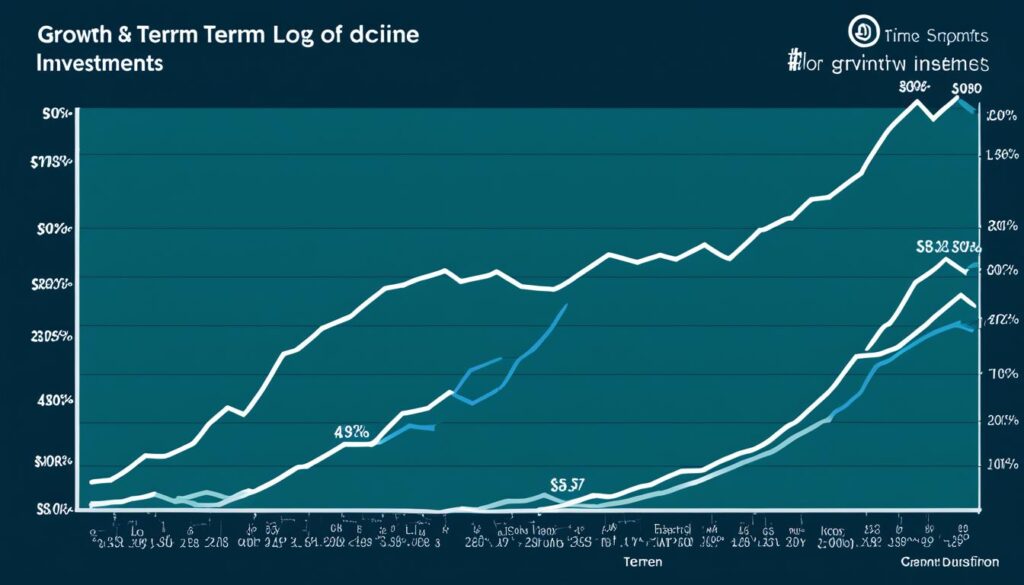
Did you know the S&P 500 has an average return of about 7% after adjusting for inflation? This shows the long-term benefits of investing. But, it’s important to know the differences between short-term and long-term investing. Your choice affects your portfolio’s growth and financial success.
Short-term investing means holding assets for a year or less. Long-term investing is for holding assets for more than a year, often 5-10+ years. Your decision depends on your goals, how much risk you can take, and when you need the money.
Long-term investing has a big advantage: compound interest. This lets your returns grow over time. Long-term investors can also spread their money across different areas to reduce risk and protect their investments from short-term ups and downs.
Short-term investing might be for those who like taking risks or need quick returns. It lets you quickly change your investments based on the market. But, it often comes with higher costs and different tax rules than long-term investing.
Choosing between short-term or long-term investing depends on your financial goals, how much risk you can handle, and when you need the money. Think about what’s important to you to make a plan that meets your financial goals.
Short-term vs. Long-term Investing: Defining the Differences
Investing time horizons are key in shaping an investor’s strategy. Short-term investors, or “active investors,” buy and sell assets often, tracking market changes daily. They focus on short-term gains and quick cash flow, aiming to make the most of current opportunities.
On the other hand, long-term investors, or “passive investors,” stick with a buy-and-hold approach. They avoid the risks of trading often. Their focus is on growth over time and spreading out their investments. These investors look at the big picture, planning for years or even decades ahead.
| Short-term Investing | Long-term Investing |
|---|---|
| Focuses on short-term price movements and high liquidity | Focuses on long-term growth and diversification |
| Involves frequent buying and selling of assets | Follows a buy-and-hold strategy |
| Seeks to capitalize on immediate market opportunities | Aims for wealth accumulation over an extended period |
| Typically holds investments for less than a year | Holds investments for several years or decades |
| Carries higher risk profiles | Carries lower risk profiles |
Choosing between short-term and long-term investing depends on your financial goals and how much you need cash. Short-term trading can lead to quick wins but also brings more risk. Long-term investing usually offers steady returns, making it a good choice for those looking ahead.

“The secret to investing is to figure out the value of something and then pay a lot less for it.” – Warren Buffett
Attributes of Short-term and Long-term Investors
Investing in the stock market shows a big difference between short-term and long-term strategies. Short-term investors are all about active trading frequency. They watch the market closely, buying and selling often to make quick profits. They value liquidity and try to time the market to make the most of trends.
On the other hand, long-term investors take a passive buy-and-hold approach. They look at the big picture, aiming for growth over many years, like for retirement savings. They’re not worried about daily price changes. Instead, they focus on the long-term potential of their investments, ready to take on more risk for the chance of bigger returns.
“Short-term investors prioritize liquidity and closely monitor daily price movements, while long-term investors follow a passive buy-and-hold approach, focusing on long-term growth.”
Choosing between short-term and long-term investing depends on your financial goals, investment horizon, and risk tolerance. Both methods have their strengths and can fit into a diverse investment plan. They offer different advantages based on your specific goals and situation.
Factors to Consider When Choosing Investment Strategies
Choosing between short-term and long-term investment strategies depends on your investment goals, time horizon, and risk tolerance. Short-term investments are good for saving for a down payment or a vacation. Long-term investments are better for goals like retirement, where you can handle market ups and downs.
Think about tax implications too. Short-term investments face higher taxes, but long-term ones might get better tax treatment. This can greatly affect your investment returns.
Also, consider portfolio diversification. Mixing short-term and long-term investments can protect you from market changes. It balances risk and reward.
Others also read this article : Fundamental Analysis: Key to Smart Stock Investing
| Factor | Short-Term Investing | Long-Term Investing |
|---|---|---|
| Investment Goals | Near-term financial needs (e.g., vacation, down payment) | Long-term goals (e.g., retirement, wealth accumulation) |
| Time Horizon | Less than 1 year | More than 1 year |
| Risk Tolerance | Higher risk tolerance for potential short-term gains | Lower risk tolerance, willing to weather market volatility |
| Tax Implications | Higher tax rates on short-term gains | Potentially more favorable tax treatment on long-term gains |
| Portfolio Diversification | Helps balance risk and potential rewards | Helps balance risk and potential rewards |
Deciding between short-term and long-term investment strategies needs a careful look at your situation, goals, and how much risk you can take. Knowing these factors helps you make smart choices. This way, you can create a portfolio that meets your investment goals.
Short-term Investment Options
Investing with a short-term focus is key for reaching goals like saving for a house or an emergency fund. Short-term investment options offer stability and quick access to your money.
High-yield savings accounts are a top choice for short-term investing. They have interest rates up to ten times higher than regular savings accounts. Certificates of deposit (CDs) are another option, offering a fixed interest rate for a set time, from a few months to years.
| Investment Option | Holding Period | Potential Drawbacks |
|---|---|---|
| High-Yield Savings Accounts | Short-term (3-6 months) | Lower returns compared to riskier options |
| Certificates of Deposit (CDs) | Short-term (3 months – 5 years) | Penalties for early withdrawal |
| Short-term Bonds | Short-term (1-3 years) | Exposure to interest rate risk |
| Money Market Accounts | Short-term (3-12 months) | Potentially lower returns than other options |
| Options Trading | Short-term (days, weeks, or months) | High risk and volatility |
Other choices include short-term bonds and money market accounts. These options may not grow as much as riskier ones. But, they offer stability and quick access to your money, which is great for short-term goals.
“Short-term investing is all about preserving capital and maintaining easy access to your funds. These options may not generate the highest returns, but they can help you achieve your immediate financial objectives.”
Long-term or short-term investing? Compare the pros and cons of these two strategies
Choosing between long-term or short-term investing affects your financial success. The main difference is in investment time horizons. Short-term investments offer quick returns but are riskier. Long-term investments are safer as they ride out market volatility.
Long-term investing benefits from compound interest. This means your returns earn more returns over time. This leads to bigger gains than short-term trading, which has higher trading costs and tax implications.
“Investing is about time in the market, not timing the market. The longer you can stay invested, the better your chances of achieving your financial goals.”
Short-term investing suits those needing quick returns or specific financial goals. It’s key to consider the risks and rewards of each strategy. Match them with your investment goals and how much risk you can handle.
Your choice between long-term and short-term investing depends on your situation and goals. A financial advisor can help you create a strategy that uses both methods for the best long-term results.
Long-term Investment Options
For building wealth over time, smart investors often choose index funds, exchange-traded funds (ETFs), stocks, and bonds. These options are kept for 5-10 years or more. This lets investors benefit from the stock market’s long-term growth and compound interest.
Robo-advisors are great for those who prefer not to manage their investments. These platforms use smart algorithms to create and manage portfolios. They help investors reach their goals of diversification and compound growth easily.
| Investment Option | Average Annual Return (1926-2019) |
|---|---|
| Portfolio with 20% stocks, 80% bonds | Approximately 7% |
| Portfolio with 40% stocks, 60% bonds (529 plans) | 8.1% |
| Portfolio with 60% stocks, 40% bonds (retirement accounts) | 9% |
| Portfolio with 80% stocks, 20% bonds (taxable brokerage) | About 9.7% |
Building a well-diversified portfolio is key to long-term investing success. It should match your financial goals and how much risk you can handle. By using the market’s long-term growth and compound growth, you can secure a better financial future.
“Compound interest is the eighth wonder of the world. He who understands it, earns it … he who doesn’t … pays it.” – Albert Einstein
Tax Implications of Short-term vs. Long-term Investing
Investing can affect your taxes, especially how long you hold your assets. Short-term gains, from assets held under a year, are taxed like regular income. This can be between 10% and 37%. Long-term gains, from assets held over a year, have lower tax rates, usually 0% to 20%.
This means long-term investing is often better for taxes. It can lead to more money over time. For example, those in lower tax brackets might not pay capital gains tax on long-term investments. Higher-income earners pay a 15% rate.
To improve your tax strategy, consider these tips:
- Time your asset sales to benefit from the more favorable long-term capital gains tax rates.
- Leverage capital losses to offset capital gains and reduce your overall tax liability.
- Invest in tax-advantaged accounts, such as IRAs and 401(k)s, to defer or avoid capital gains taxes.
Knowing the tax differences between short-term and long-term investing helps you make better choices. This can make your investments more tax-efficient and increase your returns.
Others also read this article : Technical Analysis: Key to Smart Investing
| Investment Holding Period | Tax Rate |
|---|---|
| Short-term (less than 1 year) | 10% – 37% (Regular Income Tax Rates) |
| Long-term (1 year or more) | 0% – 20% |
“Investing for the long-term can be a more tax-efficient strategy, as lower capital gains tax rates apply to assets held for over a year.”
Diversifying with Short-term and Long-term Investments
Smart investors know that mixing short-term and long-term investments is key. Short-term investments help with quick cash needs, while long-term ones can grow more over time. This mix helps manage risk, reduce ups and downs, and reach both short and long goals.
Short-term investments are for money you might need in three years or less. Early 2022 saw interest on three-year CDs rarely go above 1.10%. Options include high-yield savings, U.S. Treasury bills, money market accounts, and short-term CDs. These choices focus on portfolio diversification and risk management, giving you stability and easy access to your money.
Long-term investments look ahead to 10 years or more. They include stocks, bonds, mutual funds, ETFs, and REITs. Mixing short and long-term investments helps balance your financial aims. This way, you can meet both your short and long-term financial goals.
| Investment Horizon | Examples | Key Attributes |
|---|---|---|
| Short-term (3 years or less) | High-yield savings accounts, Treasury bills, money market funds, short-term CDs | Liquidity, stability, risk management |
| Long-term (10 years or more) | Stocks, bonds, mutual funds, ETFs, REITs | Growth potential, portfolio diversification, balanced investment strategy |
Using a diversified investment approach helps investors deal with market ups and downs. It’s great for saving for a down payment or growing your retirement savings. A mix of short and long-term investments offers the right balance for financial success.
“Most investment professionals agree that diversification is crucial for minimizing risk and reaching long-range financial goals.”
Conclusion
Choosing between short-term and long-term investments depends on your goals, how much risk you can handle, and when you need the money. Short-term investments can give you quick returns but are riskier. Long-term investments are safer but take longer to show results.
Understanding these differences helps investors make a balanced portfolio. Short-term savings offer quick cash for bills, while long-term investments grow your wealth over time. This way, you can meet your current needs and plan for the future.
The best investment plan matches your financial situation, risk level, and goals. Spreading your investments across different types and time frames can help you earn more while reducing risk. Deciding between short-term and long-term investing is personal and changes over time. It’s about finding the right mix for your financial success.





